Lexical, referential and syntactic ambiguities as Internet jokes
Aннотация
К сожалению, текст статьи доступен только на Английском
Introduction
Ambiguity is a phenomenon when a word or its combinations have multiple meanings. It can be caused by unclear quantification, coordination, or negotiation of the meaning of language construction (Aulia, 2017). This phenomenon is one of the concerns in semantics that contribute to ideas of how language, as a medium of communication, can be understood or misunderstood based on its construction performed by its users. Occasionally, language users may deliver words or sentences indicating different language literal meanings and users’ interpretations (Powell et al., 2019). This happens because language users can creatively use language in many ways. In this case, ambiguity presents the phenomenon of rich language variation related to the trade-in information it brings (Tang, 2022). Thus, it is quite possible for some contexts and occasions that unspecific or unclear meanings appear in spoken or written language (Belfahri, 2021; Hariyatmi, 2023). It is acceptable as a phenomenon in creative communication since language is rich, and language users can be creative in constructing the language they use. Therefore, the trend of using ambiguity for jokes on the internet can be a part of linguistic studies, especially in semantics.
Creative communication has been accelerated through the proliferation of technological platforms (Ardi & Rianita, 2022; Seredina & Dekhnich, 2022; Zhang et al., 2019). One prevalent form of creative language to communicate is a pun. Puns are wordplays created by individuals to construct language-based jokes. They rely on ambiguity to produce a humorous effect (Ahrens, 2018). Puns create an enjoyable emotional sense of understanding of language (Kryva, 2021) because they often utilize ordinary words and contexts to reflect literal and additional meanings. They are widely used on the internet to entertain people through humorous ambiguous jokes. Depending on the users ' creativity, they can be formed lexically, referentially, and/or syntactically, resulting in predicted and unpredicted meanings of image captions.
Despite the pivotal use of technology as a medium of communication in this digital era and the prevalence of puns as a form of creative language on the internet, there is a need to understand how the creative construction of puns contributes to the production and interpretation of humorous ambiguous jokes. Hence, the present research aims to explore the relationship between language organization and the nature of meaning by examining ambiguous meanings in internet jokes. The main focus is language-based ambiguous jokes and their connection to meaningful communication. The novelty of this study lies in the analysis of the subtleties of lexical, referential, and syntactic ambiguity present in humorous Internet memes. Being a phenomenon of mass culture and a way of communication, Internet memes, due to their illustrative nature, provide a better understanding of humor, complementing the statement with vivid imagery of the communicative situation. Since ambiguous language influences people's understanding and emotions, it is essential to clarify its meaning. Therefore, this study is relevant in the gamut of linguistics and communication because it sheds light on how language is creatively used and interpreted in online communication involving pragmatic aspects. Moreover, it contributes to understanding the role of ambiguity in creating humorous effects through multiple meanings, enhancing our comprehension of the linguistic mechanisms contributing to humor and how humor is conveyed and received in online contexts. To achieve these goals, this research examines language construction that reveals ambiguities in social communication using data from a collaborative user-generated online platform called 9GAG. The research question is as follows: What ambiguous types of jokes found in the 9GAG platform stimulate the ambiguous sense of jokes in the 9GAG platform?
Previous Studies
Pun ambiguity jokes are popular as entertainment on the internet. Linguistic researchers regard it as a phenomenon that produces various ways of language construction. Diao, Lin, Yang, Fan, Wu, Zhang and Xu (2019) researched the reasons for the use of ambiguity as jokes on the internet. Ambiguity provides a creative and attractive language with multiple meanings. Jaroenkitboworn (2020) explained the benefit of ambiguous jokes on the internet for educational purposes. This research found that ambiguity in jokes can provide a fun and funny experience to learn a language. It can be used as material in critical reading, vocabulary, or creative writing. Bulut and Almabrouk (2020) further discussed ambiguities as a kind of wordplay that presents rhetorical effects for its recipients. Its implementation represents its users’ creativity in playing with language construction to draw meanings. Furthermore, Ma’yuuf and Nashaat (2021) explained that language ambiguity can be derived from double interpretations of its actual and humorous meaning and they argued that double interpretation of language construction can be a source for studying semantics. Identically, Dewi (2021) examined ambiguity deeper as a semantic phenomenon that could lead to a breakdown in communication and misunderstanding. It revealed that the literal meaning of the language used is under the user’s authority, not the recipients’ interpretation.
The previous research proved that using language ambiguity constructions as puns are useful for language studies in semantics. Studying jokes about language ambiguity contributed to the development of both individual and social language understanding. For learners, ambiguous jokes provide a pleasant atmosphere for learning engagement. Thus, this research focused on the joke creating technique to stimulate the sense of humor in their language construction. It covered the word structure of language ambiguity and its contribution to language ambiguous meanings.
Firstly, lexical ambiguity appears when homonyms are positioned in the same place in someone’s utterances (Kreidler, 2002). It is usually caused by the natural meaning of words that create both a literal and figurative sense. This phenomenon focuses on the same words that have different meanings in a sentence. In this case, the usage of such words should have clear lexical categories and language contexts to avoid ambiguity. The lexical categories and language context are needed as additional information that can define the exact meaning of any possible meanings of a word (Saputri et al., 2019). An example of the formulation that causes lexical ambiguity in a sentence is:
Sentence : When you realize that waiting for the waiter makes you the waiter
Focused homonyms : Waiter
Lexical categories : (Noun) vs (verb + suffix)
Context : (A job) vs (a person who is waiting)
Meaning : (A person who serves in a restaurant) vs (a person who is waiting for something)
The word waiter in the sentence above can have two meanings based on how its user adds additional information about it. If its user says (When you realize that waiting for the waiter makes you the waiter) (because you serve yourself while waiting for him), the meaning of the word waiter will be defined as a job in which a person serves in a restaurant. Meanwhile, if its user says (When you realize that waiting for the waiter makes you the waiter) (because you wait for him), the meaning of the word waiter will be defined as a person, who is the doer of the action in this context, a person who is waiting for something. Therefore, the lexical categories and the context in which a word is used are the main determinants that create lexical ambiguity in someone’s language use.
Secondly, referential ambiguity appears when speakers and addressees have different referents of a referring expression (Kreidler, 2002). Generally, this phenomenon happens when language users use an object that has two or more references (Cahyani & Islam, 2017). This phenomenon can be influenced by the use of specific vs unspecific referents, unclear anaphora, general vs specific pronoun, or distributed reference vs collected reference in the word every. The examples of the formulation of referential ambiguity are: specific vs unspecific referent.
Sentence : I wanted to buy a newspaper
Focused referent : Newspaper
Specific referent : A single unit
Unspecific referent : A countable noun that is not mentioned yet
The sentence above uses the indefinite article a that can be used to refer to a word that comes after it. It can be a noun that is seen as a single unit or as a countable noun that is not mentioned yet in the conversation. If its user says (I wanted to buy a newspaper) (but I couldn’t find it), the word newspaper is referring to a specific newspaper as a single unit. Meanwhile, if its user says (I wanted to buy a newspaper) (but I couldn’t find one), the word newspaper is referring to an unspecific newspaper that uses the indefinite article to define it as a countable noun.
The phenomenon of referential ambiguity is evaluated as normal in language use, because the nature of the referring expressions that are present in a language can be used in many different contexts and occasions. Thus, the speakers’ and the addressees’ perception of the context of their conversation is the main factor that can invent or avoid referential ambiguity.
Thirdly, syntactic ambiguity is the ambiguity caused by the structural language construction. The sense of ambiguity is stimulated by the relationship of words that can be grouped in multiple ways (Fera, 2019). The formulation of the cause of syntactic ambiguity is divided into the surface and the deep structure ambiguity (Kreidler, 2002). The surface structure ambiguity is when words in a sentence can be grouped into multi-constructions. It can be influenced by the use of coordinators and and or, the combination of the coordinate head with a modifier, head with a coordinate modifier, head with an inner and outer modifier, complement with a modifier, two modifiers, or the use of certain function words. Meanwhile, deep structure ambiguity appears when there is a multi-interpretation of a group of words in a sentence. It can be influenced by the combination of a gerund with an object, an adjective with an infinitive, or the use of an ellipsis. Below is an example of a surface structure ambiguity.
Sentence : We’ll have bacon or sausages and eggs
Structure 1 : (We’ll have bacon) or (sausages and eggs)
Structure 2 : We’ll have (bacon or sausages) and (eggs)
The sentence above uses the coordinators and and or which cause the construction of the sentence to be structured in two different ways. The first structure combination interprets its meaning as we will have only bacon or the set of sausages and eggs. Meanwhile, the second structure combination acquires the meaning we will have either a set of bacon and eggs or a set of sausages and eggs. This kind of multi-construction in a sentence makes the sentence that uses the coordinators and and or ambiguous when its users analyze it syntactically. Here is an example of a deep structure ambiguity.
Sentence : I like Mary better than Joan
Structure 1 : (I like Mary better) (than Joan)
Structure 2 : (I like Mary) (better than Joan)
The sentence above uses ellipsis in a comparative construction. This formulation makes the construction of the sentence ambiguous. If the language users do not use the ellipsis in that sentence, the construction can be either I like Mary better than Joan likes Mary or I like Mary better than I like Joan. Thus, the sentence above is syntactically ambiguous for its multi-interpretation. In this case, language users should be strategic in using ellipsis considering the context in their sentences, because it can bring ambiguous meanings when the context is not clear.
Materials and Method
The aim of this research is to examine the ambiguity types stimulating humor in internet jokes. The qualitative research method was adapted to carry out the analysis of this research. In the process of applying the qualitative method, this research was done in a systematic way to present reliable evidence in explaining the category of ambiguity (Nassaji, 2020) by identifying the problem, which is the use of ambiguity as jokes, selecting puns on the internet as data, analyzing the data, explaining the results of the analysis, evaluating the results and interpreting the results as findings and available for discussion.
In conducting this research, the researchers analyzed the data collected from the 9GAG platform. The 9GAG platform was chosen since the concept of this platform is to provide self-generated content in the form of humorous videos and images. Thus, the content on this platform can show people’s creativity in using language in a jocular way. The researchers chose image-based jokes with the keyword “pun” on the 9GAG platform for the data of this research in March-April 2022. The data collected were analyzed using an observation table. The table was used to categorize language construction and its meaning based on the representation of the images identified.
While looking at the results from the observation table, the researchers determined the word structures, ambiguity types, and ambiguous interpretations of each pun. The results were then evaluated descriptively using a coding system. At this stage, the researchers processed and identified the meanings of ambiguous sentences in the images collected based on the concept of ambiguity (Kreidler, 2002). Following that, the researchers presented the findings systematically that revealed how and why the data found resulted in ambiguity and provoked the readers’ sense of humor.
Findings and Discussion
Ambiguity Types Stimulating Humor
From the 50 selected puns, it was found that three types of ambiguity were constructed as jokes by the 9GAG users. The lexical ambiguity dominates the popularity rating by standing at 56% appearing in 29 jokes. The other types found are syntactic ambiguity reaching 30% in 14 jokes and referential ambiguity standing at 14% occurring in 7 jokes. The results showed that the construction of language which stimulates ambiguous meanings of a sentence, especially when it focuses on homonyms, can provoke people’s sense of humor. The explanation of this phenomenon is that within the language ambiguity used, pun readers can find the unpredictable meanings of the puns that make sense while at the same time, that meaning is not the meaning that is expected by the readers.
Figure 1. Ambiguity Types Stimulating the Sense of Humor

Lexical Ambiguity
Lexical ambiguity in puns can provoke a sense of humour (Miller & Turkovic, 2016; Bobchynets, 2022), because the spelling or pronunciation of homonyms can present the uniqueness of the language. Since humor is closely related to people’s perspective interpretation of interaction (Çopur & Atar, 2022; Iivari et al, 2020), the use of homonyms that are also commonly found in the daily language of people’s interaction can present humor that people understand. It brings joy to people because they know the correct context of homonyms used and its interpretation in jokes is ambiguously funny and still makes sense.
Figure 2. And It’s Called a Mine. A Mine!

Sentence : I’m gonna make you mine
Focused homonyms : Mine
Lexical categories : (Possessive pronoun) vs (intransitive verb)
Context : (Pronoun) vs (action)
Meaning : (Possessive pronoun for I) vs (to dig holes to obtain coal)
In Figure 2, there are two illustrations for one sentence which explain the lexical ambiguity that comes along with the word mine. This phenomenon appears because the word mine belongs to the lexical category of the possessive pronoun and intransitive verb. Interestingly, the lexical categories of the possessive pronoun and verb in that sentence can be used in the same position.
The sentence construction in Figure 2 can be interpreted in two ways based on how its users understand its key word meaning and lexical category. The key word found in the picture above is the word mine. The ambiguity is explained when the upper image used the word mine as a possessive pronoun that refers to the word I. Meanwhile, in the lower image, the word mine is used as a verb that refers to the activity of retrieving coal in the ground.
In this sentence construction, the homonym mine is used to produce a humorous effect when the girl in the image says yes. At this point, pun readers can understand that the interpretation of the homonym mine is she is expecting the boy to propose to her. Humorously, pun readers find that the interpretation of the homonyms mine turns out to be an unbelievable surprise when the man brings her to a place for mining as shown in the lower image. It is not the meaning of the word mine that the girl was hoping for.
Figure 3. *Can’t Even Type Title*
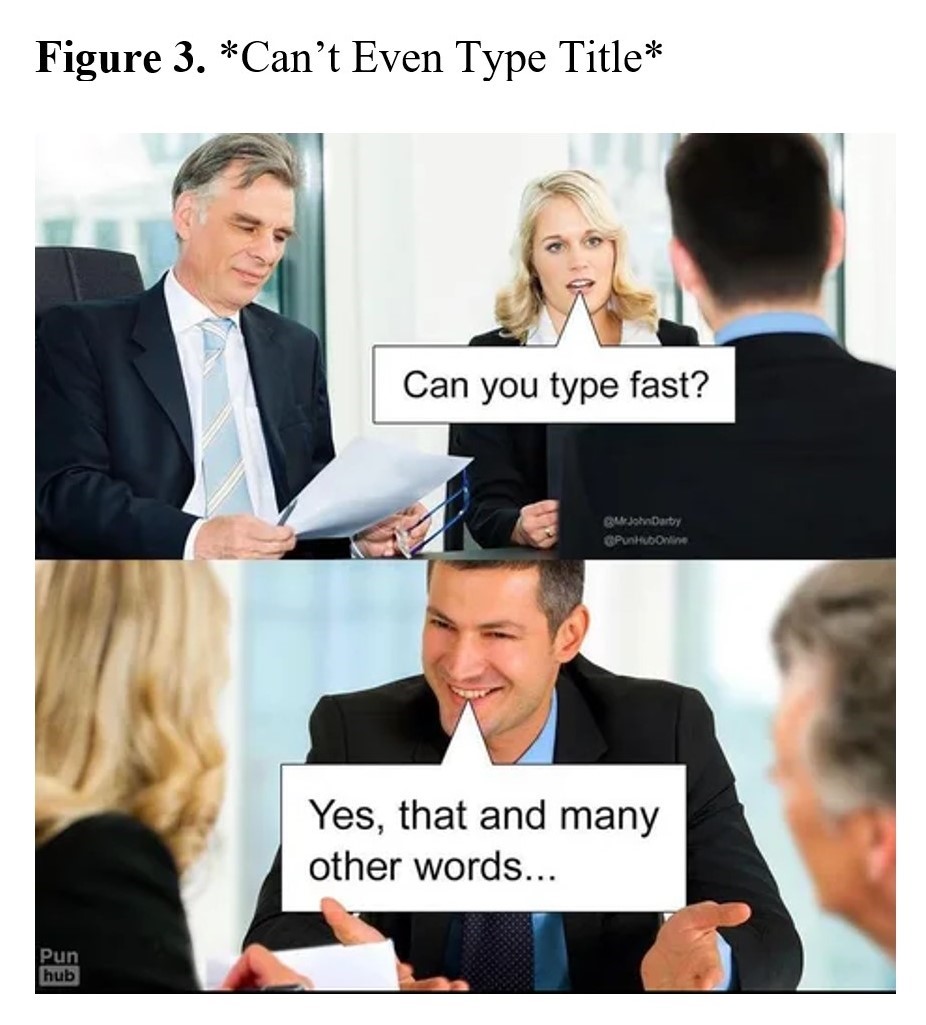
Sentence : Can you type fast?
Focused homonyms : Fast
Lexical categories : (Noun) vs (adverb)
Context : (Word) vs (manner)
Meaning : (Type the word fast) vs (type something fastly)
In Figure 3, the lexical ambiguity is in the different perceptions between the speaker and her addressee about the meaning of the homonym fast. The source of this phenomenon is the lexical categories of the homonym fast itself which can be categorized as a noun and an adverb. In ambiguous constructions like the one presented in the image above, these different lexical categories can influence the meaning of the homonym fast. In this context, it can produce a humorous effect when its users face a misunderstanding of the use of that homonym.
Focusing on the construction of the sentence, in the upper image, pun readers can see that the speaker used the word fast as an adverb that explains the manner of typing words quickly. However, in the lower image, the addressee answers the question of the speaker in a different context. He assumes that the homonym fast belongs to the lexical category of the noun. Thus, he thinks that the question is whether or not he can spell the word f-a-s-t.
In this construction, the homonym fast produces a humorous effect when pun readers find that the addressee answers the question in a different context but they know that he is neither right nor wrong. It is hilarious to find that rather than thinking about the adverbfast, the man considers the homonym fast as the noun of the question. The humorous sense is in its punchline when pun readers find that the man assumes that the context of the question is to write the word by spelling f-a-s-t.
Figure 4. No, It’s Not.[1]

Sentence : Do you need me to sign?
Focused homonyms : Sign
Lexical categories : (Verb) vs (verb)
Context : (Movement) vs (signature)
Meaning : (Use gestures to deliver information) vs (write the name on paper)
In Figure 4, lexical ambiguity appears when the man misinterprets the homonym sign that the woman uses in her utterance. This phenomenon happens because of the multiple meanings the homonym sign brings to that sentence formation. Even though the lexical category is obviously a verb since the construction is in the to-infinitive form, the natural meaning of the homonym seems to be ambiguous because of the context. The woman mentions in the context that she should put her signature after receiving a consignment. However, the man in the context assumes that they can use verbal or sign language while communicating.
Considering the context of the conversation, in the upper image, pun readers can see that the woman uses the homonym sign to ask whether or not she should add her signature as proof that she has received the consignment. Surprisingly, the man in the lower image thinks that the woman is asking whether she should communicate in sign language or verbally with him. This pun is an example that the meaning of language is highly dependent on how its users regard the context of the conversation to draw up an interpretation.
The humor in this pun appears when pun readers read the caption in the lower image. It is hilarious to find the man claiming that his hearing is perfect. In fact, pun readers know that the meaning of the homonym sign that the woman points out is to add her signature since she has a ballpoint and paper in her hands. However, the man just assumes that the woman expects him to be a person with impaired hearing. Thus, he says no thanks, my hearing is perfect to tell the woman that he is normal and can communicate verbally with her.
Referential Ambiguity
Referential ambiguity produces a humorous effect by constructing a language structure purposively requiring less information about the context (Kirner-Ludwig, 2018). Less information about the context may confuse the speakers’ and addressees’ different perceptions of the referent in a sentence. In daily conversation, people who are involved in a conversation have their own conception of the representation of language signs which refer to someone or something (Taghiyev, 2020). In this case, the lack of information about the referent may cause some ambiguity for them. The funny things happen when everyone involved in the conversation reveals his or her interpretation of the referent, which may be unexpected to the other conversation participants.
Figure 5. To the Point

Sentence : Is this her first child?
Anaphora : The pronoun this
Possible referent : the labour process/ the person who is talking
In Figure 5, the referential ambiguity occurs when the anaphora this seems unclear for both the man and the woman. In his first sentence, the man offers two referents which both can use the anaphora this to avoid repetition. Those referents are labour and I. In his sentence construction, if the sentence that comes after it uses the anaphora this, the referent of the anaphora may be different based on his and his addressee’s conception of the context of their conversation.
In the upper image, pun readers can find that the man’s utterances concern two matters which are his wife going into labour and himself. The personal pronoun this is used in the woman’s utterance for expressing referential ambiguity. It can refer to labour in giving birth as the woman assumes or it can refer to the man himself as being the husband. In this case, pun readers can see that the man and the woman cannot deal with the context of their conversation.
In analyzing humor in this pun, there is a misunderstanding in the man’s answer in the lower image. The joke is that the man, apparently out of excitement, forgetting that he has already introduced himself as a husband, misinterprets the question of a medical worker and introduces himself again, explaining that he is not the first child, but the husband. It becomes funny since readers cannot blame the man for his answer because it also makes sense.
Figure 6. I wish I could be Ugly for One Day

Sentence : I wish I could be ugly for one day
Focused referent : One day
Specific referent : A single day
unspecific referent : Sometime in the future
In Figure 6, the referential ambiguity occurs when the speaker in the image plays with his expressions to bring different referent interpretations to the words one day. In the construction of his sentence, the word one can be referred to differently when it is combined with the word day, because, in daily language, people can use the term one day to state the number of days or to state sometime in the future or past that refers to the time of a situation.
In the upper image, the man acts in a cool manner while saying I wish I could be ugly for one day. In this situation, pun readers may think that the man wants to be ugly for some unspecific time in the future, because he is bored with his cool handsome face. But looking at the lower image, pun readers will understand that the day that the man refers to is a specific number of days he is wishing for. With the words, Cuz being it every day is really sad, pun readers can conclude that one day refers to one of many days in the man’s life.
Humor comes in when the man’s facial expression changes and the caption at the bottom of the image explains the meaning of the sentence of the upper image. It is funny to think that he considers himself a cool handsome man who wants to be ugly at a certain time in his life but the reality is he wants his ugliness to last only for one day because it saddens him to be ugly for the whole duration of his life.
Figure 7. I’ll See Myself out

Sentence : Tonight has been amazing, we should have dinner again.
Focused referent : Again
Definite referent : Tonight
Indefinite referent : Sometimes
In Figure 7, the referential ambiguity appears in the time referent which the speaker expresses through the word again. It becomes ambiguous because the word again explains the repetition of an activity, which is dinner in the image above. In this case, language users can interpret the time for repeated actions in multiple ways. In the image above, ambiguity is found in the part when the woman invites the man to have dinner some time again, but the man thinks she is asking to have dinner again that night. This phenomenon happens because the woman does not explain the context of the time, she refers to in her language construction.
In the upper image, pun readers find that the woman is content with the dinner she had with the man. That is why she compliments the dinner and suggests they have another one. In her language construction, the woman says tonight has been amazing, which means she is happy about the whole night. Therefore, it can be assumed when she suggests having another dinner, the time of the dinner is on another night indefinitely. However, the man seems to have a different interpretation of the word again. He loses the context of the time that the woman means. As a result, he says thanks, but I’m full because he thinks that the woman wants to have another dinner right there and then.
Humor comes in when pun readers learn that the man has a chance to meet the woman for dinner on another night. However, the man seems to mess it up by rejecting the woman’s offer because he thinks the woman is asking him for one more dinner at that given time. It must be embarrassing for the man if that conversation continues in the same manner. In this ambiguous joke, pun readers can laugh by imagining the man’s reaction when he realizes that he has misinterpreted the woman’s utterance.
Syntactical Ambiguity
People are commonly constructing puns within syntactical ambiguity to make jokes about a sentence’s meaning (Attardo, 2018). This phenomenon is caused by the flexible meaning that a word can stand for based on the language construction. Thus, syntactic ambiguity is evaluated as a phenomenon that occurs in the grammatical category (Okunade, 2021). In this kind of ambiguity, humor appears when speakers and their addressees rely on different structures of the same sentence construction. It makes the meaning that is expected by the speaker different in the addressee’s interpretations and brings the conversation round to an unexpectedly different context.
Figure 8. I Know How to Count!

Sentence : Yes, I have one that’s just under two
Structure 1 : Yes, (I have one) (that’s just under two)
Structure 2 : Yes, (I have) (one that’s just under two)
In Figure 8, the syntactic ambiguity occurs in the surface structure of the girl’s sentence. The girl constructs her sentence with I have one as the head of the group of words along with that’s just under two as its modifier. In this construction, the ambiguity appears in the word one that can belong to two different groups of words as seen in Structure 1 and Structure 2.
In this case, the girl who deals with the meaning of the first construction of the word structure interprets the meaning of the sentence as the girl having one child whose age is under two. On the other hand, the man, who deals with the second construction of the word structure interprets the meaning of the sentence as the girl having two children and informing him that one child is younger than the other one. These different meanings both make sense since the pause in the sentence users’ speech can be varied.
Based on the analysis, humor in this pun appears when pun readers find that the woman answers the man’s question correctly and within context. However, it seems that the man just assumes that the woman is out of context by showing his understanding, while in fact, it is him who is out of context in that conversation. It is amusing to find the man’s unpredictable reaction to the right and in-context information given by the woman.
Figure 9. Now It’s a Yellow Page

Sentence : Honey, please put mustard on the shopping list
Structure 1 : (Honey, please put mustard) (on the shopping list)
Structure 2 : (Honey, please put mustard on) (the shopping list)
In Figure 9, the syntactic ambiguity occurs in the surface structure when the woman uses the phrasal verb put on that adds a certain function to the language structure construction. The literal meaning of the phrasal verb put on is to put things on other things. So, it needs two objects when this phrasal verb is used in a sentence. However, it can be constructed differently based on the context where it is used. It is possible to have only one object in the sentences and it is also possible that the meaning is not putting something on something else because of the context of the language use.
In Figure 9, the man interprets the phrasal verb put on through its literal meaning which means he should add mustard to something to be eaten with. However, the use of the phrasal verb put on in that sentence is actually to include mustard as a thing that wants to be bought. Thus, the right thing to do is to add the word mustard to the shopping list. The context of this conversation is marked by the presence of the words shopping list which is used to list things that will be bought. Unfortunately, the man in the image just ignores this context and is ending up doing the literal meaning of the sentence in the woman’s instruction.
Humor in this pun appears when pun readers can see the man’s action to the instruction given by the woman. Naturally, ambiguity in language can be avoided if people can engage in the context of a conversation. However, pun readers can see that the man in the image just loses the right context and brings out the literal meaning of the woman’s sentence. It is hilarious to find him in confusion while looking at the shopping list that is covered with mustard. It becomes funnier since pun readers learn that the mess on the shopping list is caused by himself who misunderstands the instruction given to him.
Figure 10. Beaucoup Money
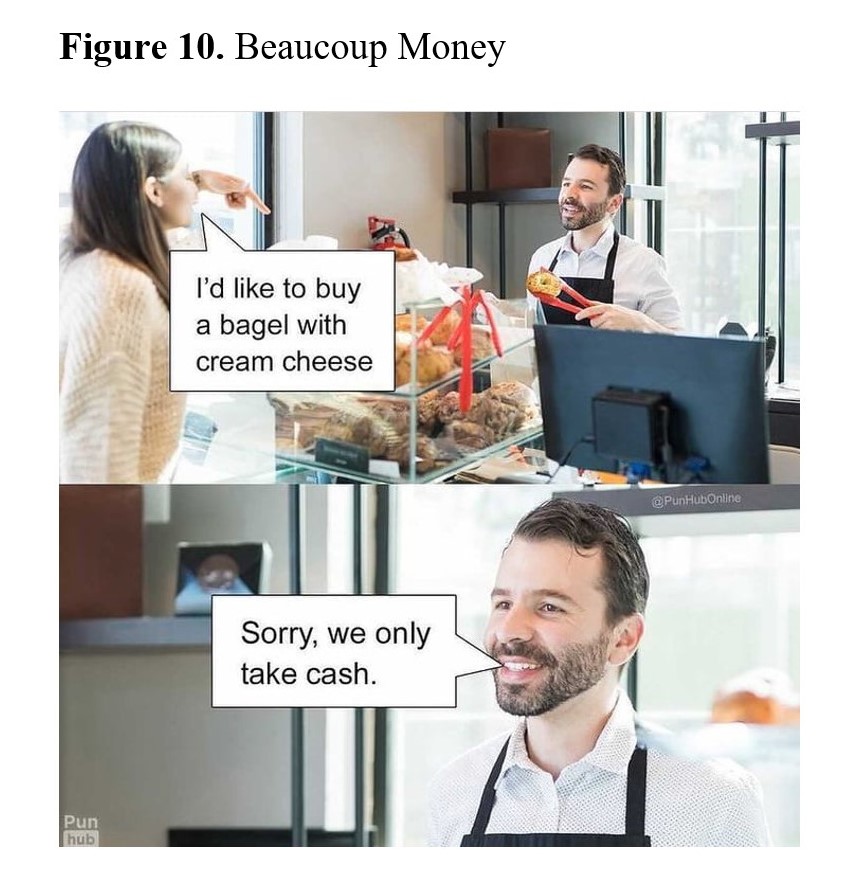
Sentence : I’d like to buy a bagel with cream cheese
Structure 1 : (I’d like to buy a bagel) (with cream cheese)
Structure 2 : (I’d like to buy) (a bagel with cream cheese)
In Figure 10, the syntactic ambiguity occurs in the surface structure when the speaker constructs her language with a complement and modifier. In this construction, the modifier can be positioned in two formations. The first is in the group of words with cream cheese and the second is in the group of words a bagel with cream cheese. In this case, the meaning of the full sentence can be interpreted in two ways as well. It depends on how the language users position the modifier of the sentence in their mind to be interpreted.
In the image above, the girl relies on Structure 2 which means she uses a bagel with cream cheese as the modifier. However, the man relies on Structure 1 because he assumes with cream cheese to be the modifier. The result of this different interpretation of the modifier is the misunderstanding that pun readers can find in the woman’s and the man’s conversation. Based on the image and the caption, pun readers learn that the woman says that she wants to buy a bagel with cream cheese spread on it. However, the man thinks that the woman wants to buy a bagel and that she will pay for it with cream cheese. Therefore, the man says Sorry, we only take cash.
The humorous effect in this pun appears when pun readers find that the man misinterprets the woman’s utterances. When the readers see the upper image, they find that everything is normal. The woman wants to buy a bagel with cream cheese spread on it, which pun readers also experience in their life. However, the man in the upper image says that she can only pay for the bagel with cash. In a normal context, pun readers know that people buy things with cash, not cream cheese. Thus, pun readers find it funny when the man thinks that the woman wants to use cream cheese to pay for her bagel when she just wants her bagel with cream cheese spread on it. The man’s interpretation makes the normal meaning of the woman’s sentence sound funny.
Based on the discussion of ambiguity found above, the researchers confirmed that the results of this study showed that people on the 9GAG platform used different types of ambiguities to stimulate a sense of humor for others. In presenting the jokes, they also present the images to help pun readers understand the context of the jokes given. Then, for language construction, this study found that ambiguity can come in different parts of an utterance. The result of this research is linear to some previous studies. It was found before that the context of language use is important in deciding the meaning of ambiguous language (Cevoli, Watkins, Gao & Rastle, 2022). It was also found that ambiguity can be varied from only one word up to all the words of an utterance, because the meaning of an utterance is influenced by every word of the utterance (Juliana, Nadirah, Lababa & Manda, 2022). In addition, the results of this research are mostly based on the ambiguity that occurs between a speaker and an addressee. The meaning of the utterances given can be mostly understood in the context that is revealed by the images of the puns. It shows that ambiguous words can be avoided when both speakers and addressees have the same perception of the meaning of words and contexts. Thus, the speakers need to provide the context that they mean in their utterances. It is also important for the addressees to focus and be able to harmonize their understanding of the words delivered by the speakers (Lord & Brown-Schmidt, 2022). On the whole, it is the responsibility of both the speakers and addressees to contribute to a smoothly running conversation to avoid ambiguity in communication.
Conclusion
The results revealed types of language ambiguity in humorous Internet memes; all the lexical, referential, and syntactic ambiguities can be used as jokes. The 50 ambiguities were distributed as follows: 29 jokes (56%) lexical, 14 (30%) syntactic and seven (14%) referential. The ambiguous implementation of jokes is advantageous to both people’s sense of humor and language knowledge. It provides people with entertainment and views of language structure construction. It can be a fun way for people to learn a language. The researchers recommend the use of ambiguous jokes as a source of learning the English language, especially for non-native learners, because learning ambiguous jokes can give various insights into the language structure and its various meanings. However, the English jokes should be carefully selected so that the tricks look natural. As jokes are culturally bound, and English is widely spoken around the globe, introducing English jokes produced by different cultures to English learners can instigate their intercultural communicative competence (Iswandari & Ardi, 2022). Moreover, in discussing ambiguity, language learners can also find the factors that have an impact on appropriate language that results in successful communication, including conversation context and speaker-addressee perception. Indeed, the learning process will cease to be boring if the sense of humor concealed in ambiguous jokes is revealed.
The researchers realized that this study only selected a few samples within a short time. Thus, the findings only cover the popular jokes in March-April 2022 and the depth of the discussion is only limited to the jokes people share on 9GAG at that time. Since the issue of this topic may develop along with the development of language trends from time to time, the researchers suggest future researchers cover the development of the use of language ambiguity. It may give more understanding of how people’s creativity in using language could be different considering the period of time and trends in society. Furthermore, this research discovered that syntactic ambiguity which is formulated in deep structure ambiguity was not found in the jokes on the 9GAG platform. The researchers found that it was influenced by the complex interpretation of the words constructed in the deep structure ambiguity. In this case, future researchers can focus on this phenomenon to find its factors and language users’ perceptions of it. It would expose the topic of ambiguity in a different context and present more understanding of the implementation of language ambiguity, particularly in Internet memes.
Appendix. Data and Analysis
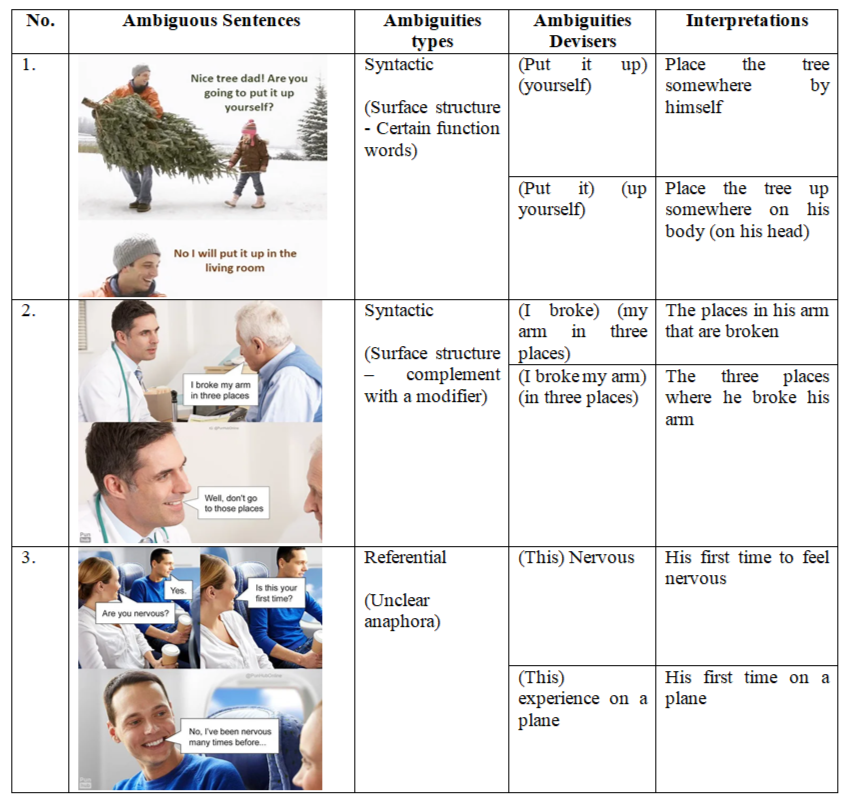
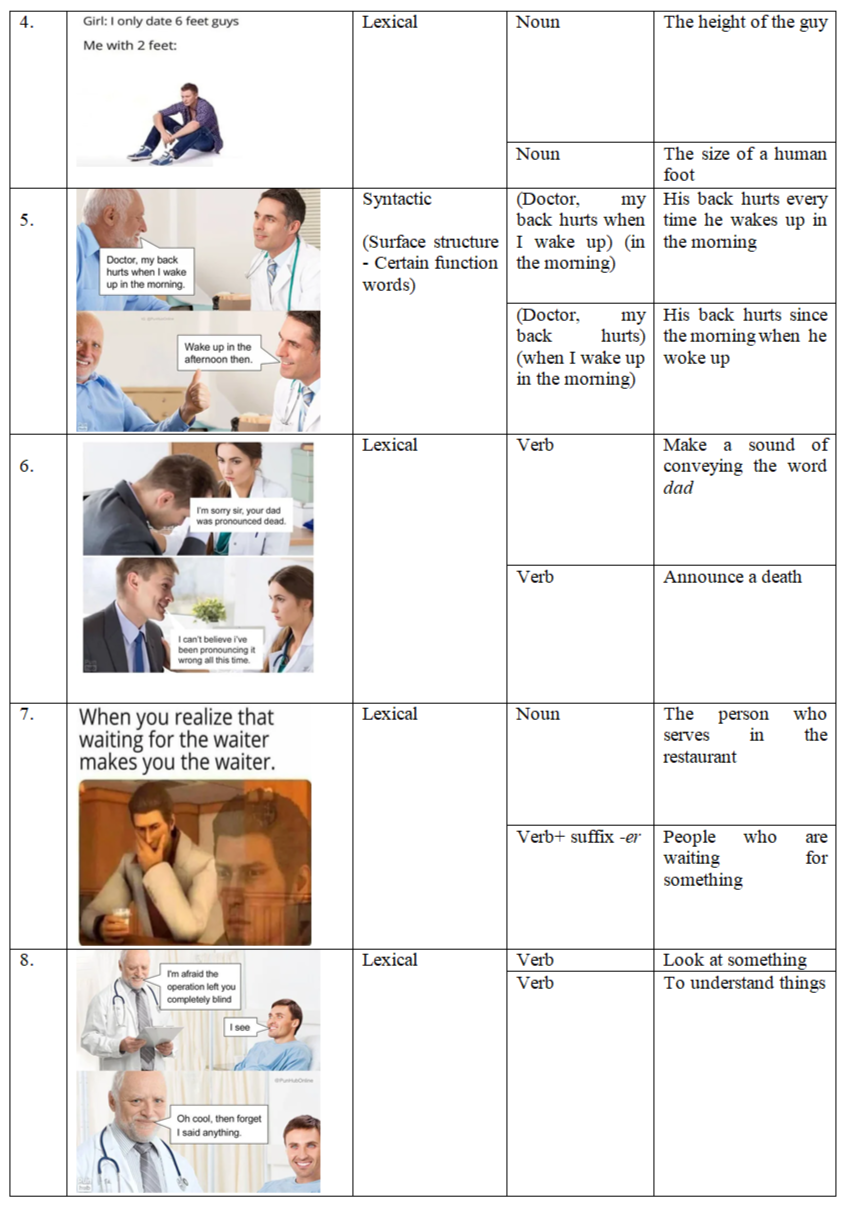
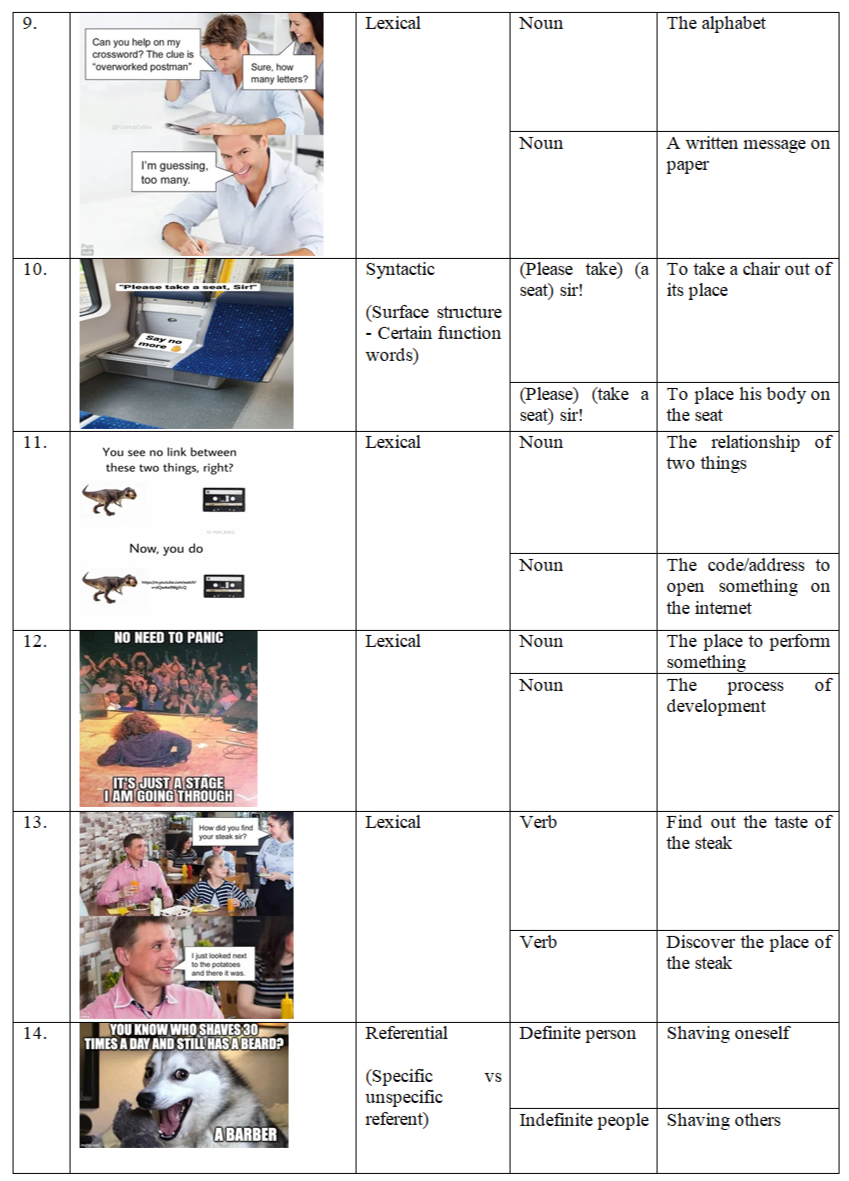

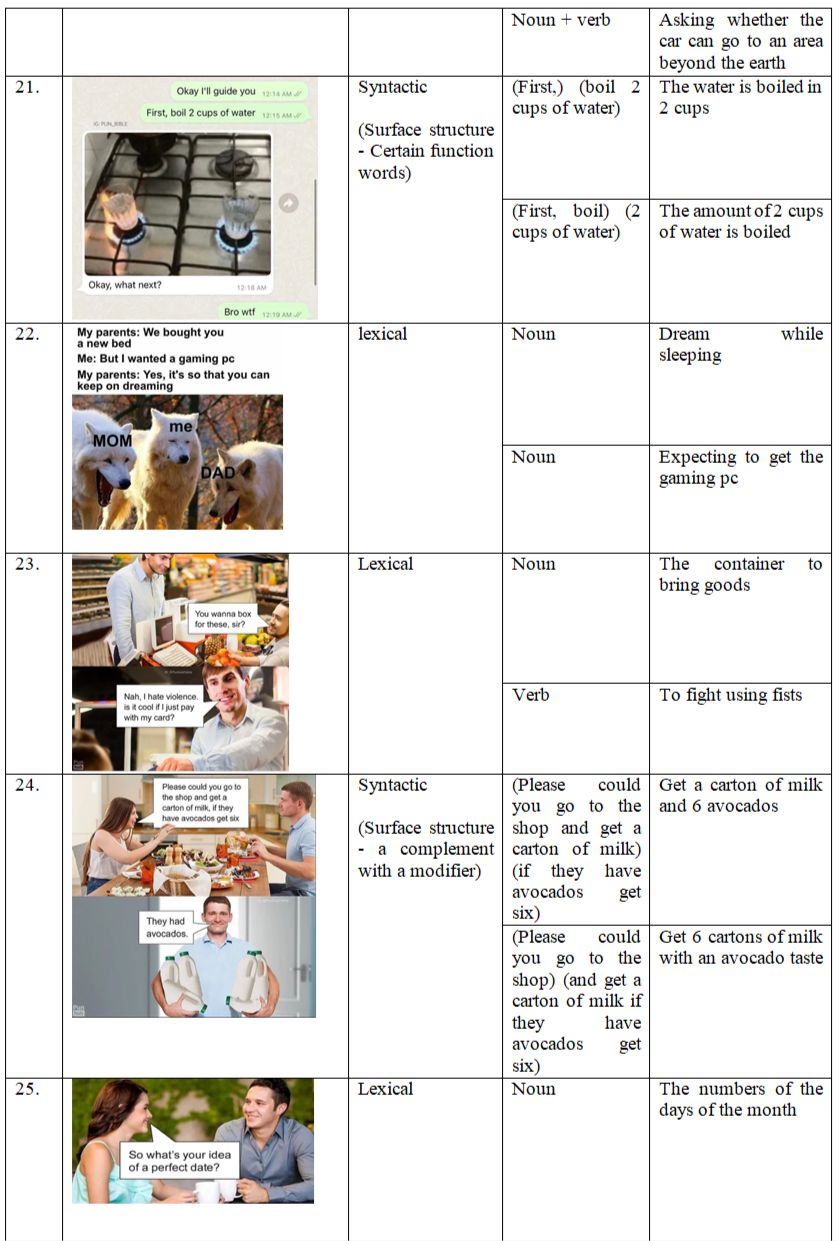
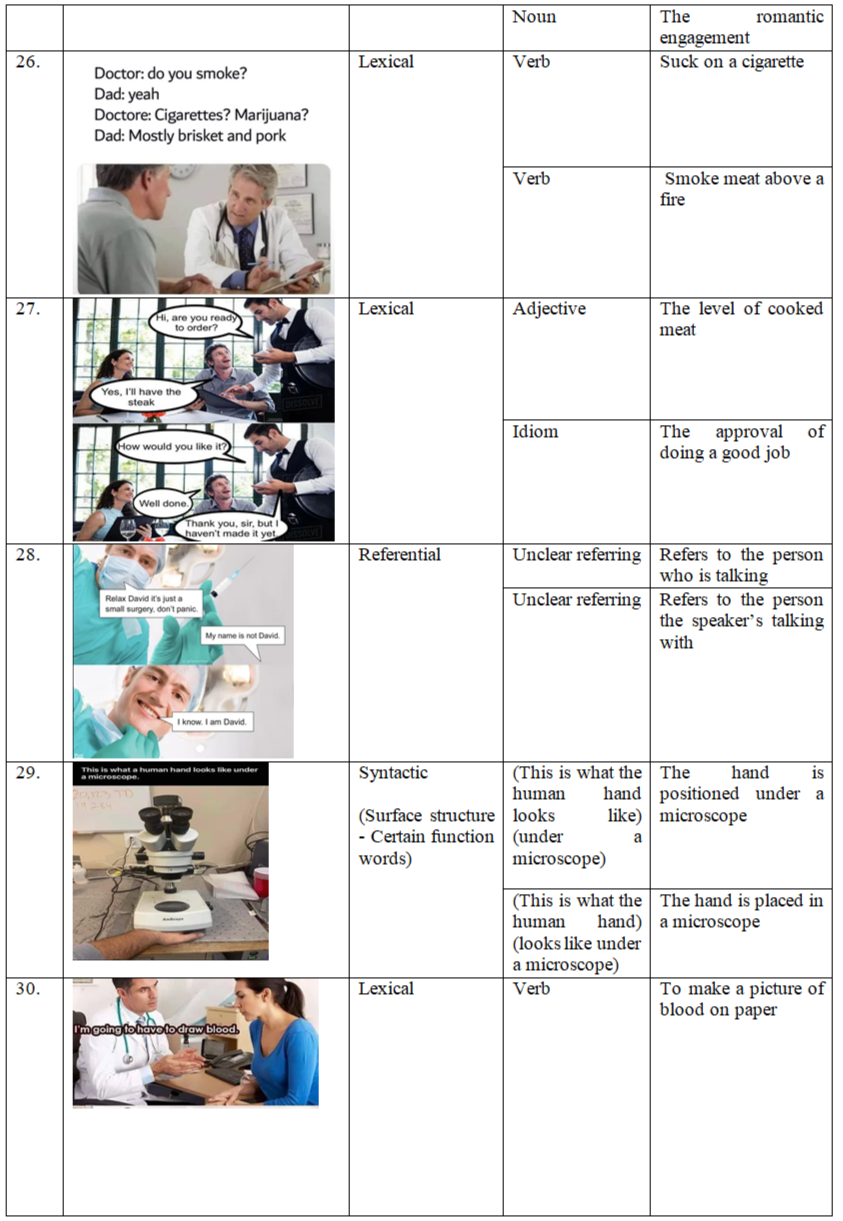
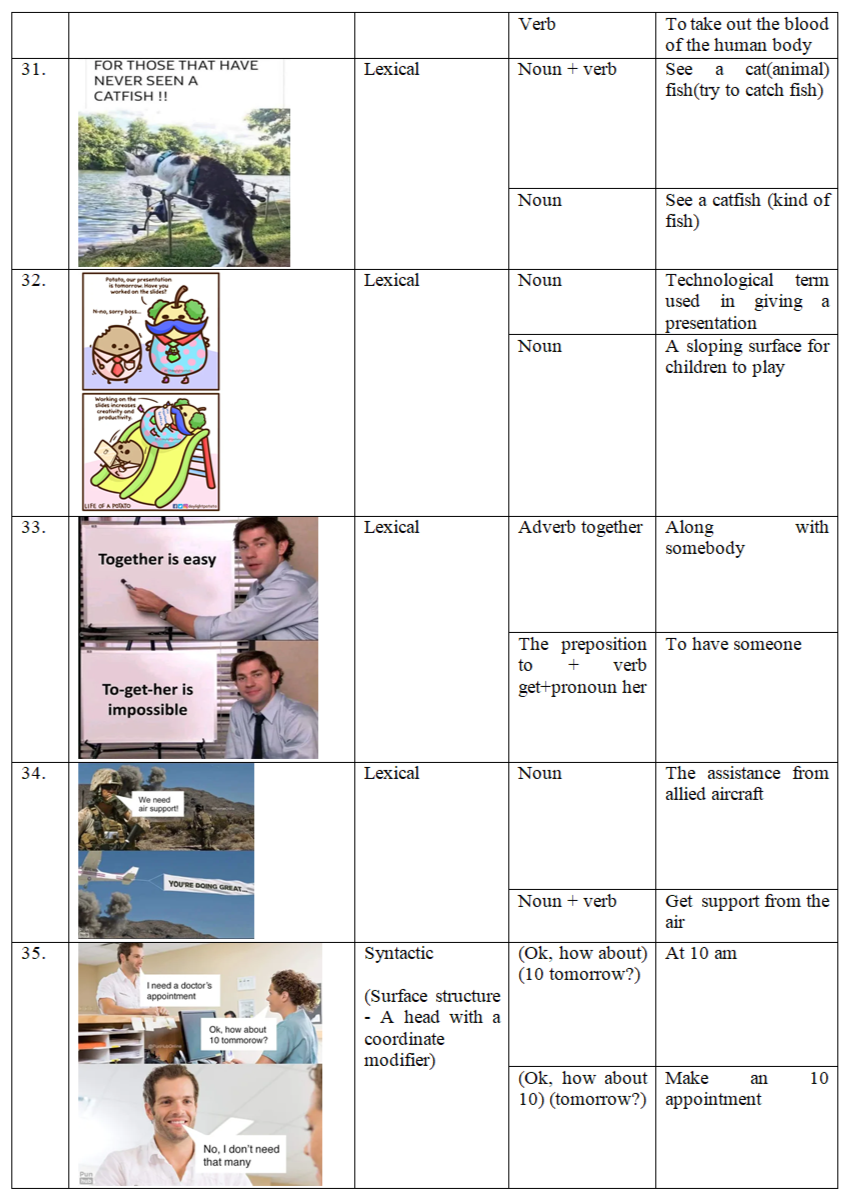




















Список литературы
Список использованной литературы появится позже.